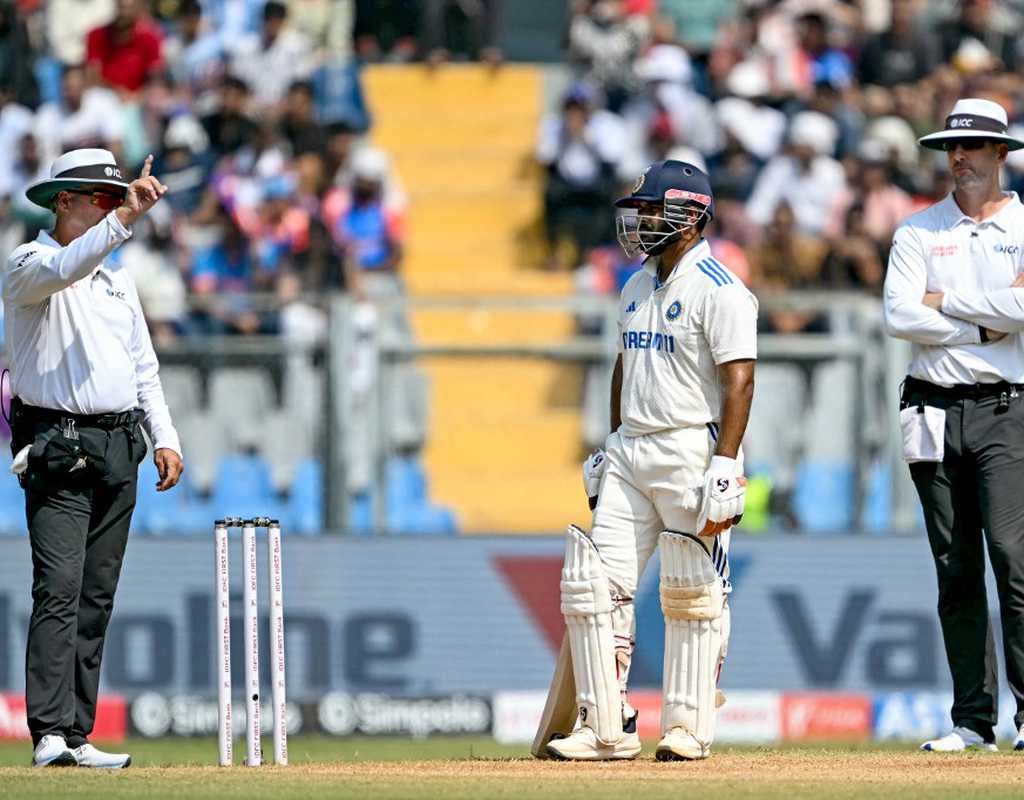Rohit Sharma Expresses Disappointment Over Controversial Umpiring Decision in Mumbai Test
The cricket world was abuzz with discussions following a controversial decision made by the third umpire during the recent Mumbai Test match between India and New Zealand. The decision to rule Rishabh Pant out sparked widespread debates among pundits and fans worldwide.
The Controversial Dismissal
On the third day of the Test match, Rishabh Pant’s sensational innings came to an end in a somewhat controversial manner. In the 22nd over of India’s chase, Pant was given out after a referral by New Zealand. Umpire Richard Illingworth initially ruled it ‘not out,’ but the decision was overturned after UltraEdge picked up a ‘spike’ as the ball passed the bat.
Indian captain Rohit Sharma weighed in on the decision during the post-match press conference, expressing his confusion over why the on-field umpire’s decision was overturned. He emphasized the importance of consistency in umpiring decisions and stated that if there is no conclusive evidence, the on-field decision should stand.
Reactions from Players and Experts
Former South Africa captain AB de Villiers took to social media to highlight the grey area in the use of technology in such situations. He questioned whether Pant had actually made contact with the ball and emphasized the need for consistent calls and good use of technology in cricket.
New Zealand captain Tom Latham, on the other hand, mentioned that the decision to review was based on the close-in fielders hearing two noises. He stated that once the decision is referred to the umpire, it is out of the players’ control, and they must respect the final call.
Impact on the Match
The controversial dismissal had a significant impact on the match, with India eventually falling to a 25-run loss and a 0-3 series sweep by New Zealand. Rohit Sharma lamented the loss of momentum caused by Pant’s dismissal, as the wicketkeeper-batsman was looking set to lead India to victory.
Overall, the Mumbai Test match will be remembered not only for the thrilling cricketing action but also for the contentious decision that sparked debates across the cricketing fraternity. It serves as a reminder of the importance of clear and consistent umpiring decisions in the sport.
Umpiring in Cricket: A Balancing Act
Umpiring decisions have always been a crucial aspect of cricket matches, often determining the outcome of games and sparking heated debates among players, fans, and experts. The use of technology, such as UltraEdge and ball-tracking systems, has added a new layer of complexity to decision-making, offering both benefits and challenges in ensuring fairness on the field.
While technology aims to provide more accurate decisions, the human element in interpreting the data remains a significant factor. Umpires are tasked with balancing the evidence presented by technology with their on-field observations and experience, making split-second judgments that can have a profound impact on the game. The recent incident in the Mumbai Test exemplifies the fine line that umpires walk in making such decisions.
The Evolution of Umpiring and Technology
Over the years, cricket has witnessed a remarkable evolution in umpiring standards and the incorporation of technology to aid decision-making. The Decision Review System (DRS) has become a standard feature in international cricket, allowing teams to challenge on-field decisions and seek a review through technology. While DRS has undoubtedly improved the accuracy of decisions, it has also raised questions about its effectiveness and consistency.
The controversy surrounding Rishabh Pant’s dismissal in the Mumbai Test underscores the ongoing debate about the role of technology in umpiring. While some argue that technology should be embraced to eliminate errors, others believe that it can lead to overreliance and detract from the essence of the game. Finding the right balance between technology and human judgment remains a key challenge for cricket’s governing bodies.
The Psychological Impact of Umpiring Decisions
Beyond the technical aspects, umpiring decisions can also have a profound psychological impact on players and teams. A contentious decision, such as the one in the Mumbai Test, can shift momentum, influence player confidence, and ultimately sway the outcome of a match. Players must navigate the emotional rollercoaster of accepting umpires’ calls, whether in their favor or against them.
Rohit Sharma’s disappointment over the controversial decision reflects the frustration felt by players when such calls go against them. The mental resilience to bounce back from such setbacks and refocus on the game is a crucial aspect of a player’s mentality in high-pressure situations. Umpiring decisions not only test players’ skills but also their mental fortitude and ability to overcome adversity.
Looking Ahead: The Future of Umpiring in Cricket
As cricket continues to evolve, the role of umpires and technology in decision-making will undoubtedly undergo further scrutiny and refinement. Striking a balance between accuracy, fairness, and preserving the spirit of the game will be paramount in shaping the future of umpiring in cricket. Embracing innovation while upholding traditional values will be a delicate balancing act for cricket’s stakeholders.
Ultimately, the Mumbai Test incident serves as a catalyst for introspection and dialogue within the cricketing community. It prompts us to reexamine the intersection of technology and human judgment, the impact of umpiring decisions on the game, and the ongoing quest for excellence in officiating. In the ever-evolving landscape of cricket, umpiring will remain a cornerstone of the sport, influencing its dynamics and narratives for generations to come.

